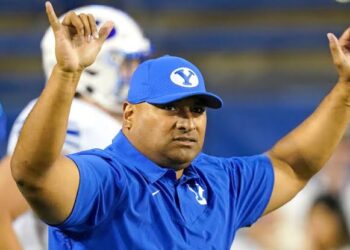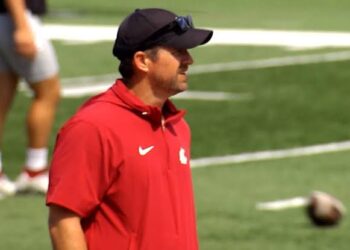Kirk Herbstreit Calls for College Football to Ban Pre-Snap Signals in New Controversy
In a passionate discussion during Saturday’s college football broadcast, ESPN analyst Kirk Herbstreit stirred debate by calling for a sweeping change to the sport—banning pre-snap hand signals. The renowned commentator, a fixture in college football coverage, argued that the growing reliance on these signals is not only slowing the pace of games but also diminishing the sport’s authenticity and competitive balance.
The Issue at Hand
Pre-snap signals have become increasingly common in college football. These intricate systems, featuring sideline gestures, placards, and even dummy calls, are designed to communicate plays quickly and counteract opponents’ efforts to decipher strategies. While efficient, the practice has faced criticism for creating unnecessary delays and complicating an already nuanced game.
Herbstreit addressed the matter during a segment of ESPN’s “College GameDay,” emphasizing the frustration it causes for fans and players alike. “It’s time for college football to rethink the use of pre-snap signals. These constant stops and adjustments are taking away from the rhythm and excitement of the game,” Herbstreit remarked.
Impact on the Game
Supporters of Herbstreit’s proposal argue that banning pre-snap signals could streamline gameplay and encourage teams to rely more on traditional methods of communication, such as huddles and verbal cues. They believe this shift would enhance the flow of games, reduce the need for excessive pauses, and place greater emphasis on players’ adaptability on the field.
Critics, however, counter that pre-snap signals are a crucial tactical tool in modern football, especially in high-pressure situations where audible communication may be hindered by crowd noise. Removing them, they argue, could put teams at a strategic disadvantage and disproportionately affect those with less experienced quarterbacks or less cohesive offensive units.
A Broader Trend?
Herbstreit’s call reflects a broader concern among football purists about the increasing complexity of the game. From helmet communication devices to extensive video analysis, technology and innovation have transformed football into a chess match, often at the expense of its raw, fast-paced nature. Some worry that these changes alienate fans who long for the simplicity of old-school football.
What’s Next?
Whether Herbstreit’s suggestion will gain traction remains to be seen. The NCAA and college football stakeholders would need to weigh the potential benefits of such a ban against its practical implications. Implementing changes to pre-snap communication could require a fundamental rethinking of offensive play-calling and sideline dynamics.
For now, Herbstreit’s remarks have sparked a lively debate in the college football community. Fans, coaches, and analysts are weighing in on social media, with opinions divided between those who welcome a return to tradition and those who see the evolution of signaling as a natural progression of the sport.
As the college football season marches on, one thing is certain: Kirk Herbstreit’s call for change has ensured that pre-snap signals will be a hot topic for weeks to come. Whether it leads to meaningful reform or remains a point of contention, the discussion underscores the ever-evolving landscape of college football.










